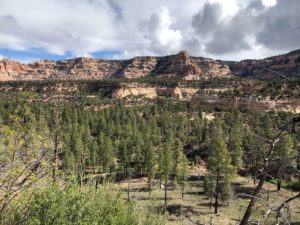 In the distance are two small buttes that protrude from the gently curved ground covered in sagebrush and juniper. These are the Bears Ears.
In the distance are two small buttes that protrude from the gently curved ground covered in sagebrush and juniper. These are the Bears Ears.
Driving up several days later, we stop in between them. Looking down from the buttes the landscape slopes into flat plains which seep out until the horizon is created against the blue sky. In the opposite direction are subtle hills, rich with pinyon, Douglas fir, and various other pines. These provide a foreground for rigid mountains that are sudden and striking when compared to their surroundings.
Hiking down on our first day, we are encompassed by pine trees that are practically transparent because of their open branches that are angled, reaching up to the sky. When the trees part we can see pale orange and white canyon walls on either side of us, terraced with vegetation.
Our second day, we venture up the spine of a ridge and continue on until it curves back on itself in layers of slick rock. Carefully we climb up. On the last ledge that is safe enough for us to balance on, there is a granary. Dried mud and stone form the walls against the corner of the alcove. There is an opening that has been created to fit a specific rock that seals the granary from the outside. We observe and wonder about the people who engineered it.
The following six days are filled with the sound of excited water, open canyon valleys, vibrant paintbrush, hummingbirds, high alcoves, emerging arches, and almost no sightings of other people.
This special place has been the source of controversy in our country since its designation as a National Monument. Before becoming Bears Ears National Monument, this land was under the jurisdiction of the Forest Service and Bureau of Land Management (BLM), which is a multi-purpose agency. Under the title of National Monument, in Obama’s vision, Bears Ears would still be managed by these agencies, and a board of advisors including five tribal leaders and representatives of the Forest Service, BLM, and the Park Service. However, this vision was never brought to fruition and the size of the monument was reduced by the following administration.
Both Obama and Trump carried out these respective actions and claimed to be doing so for the benefit of the people. My question is, which people? There are, “…tribal connection[s] that certain Navajo clans, the Hopi, Zuni, Utes, and other tribes of the Southwest, have to Bears Ears” (Bitosi, 2017). There are also tourists and outdoor enthusiasts drawn to the preservation of pristine land. There are also towns close to the National Monument such as Blanding and Monticello that started off as Mormon settlements. All of these parties find themselves affected by the actions of the federal government. And so begins a battle of who belongs there, who has say over the land, and who is an outsider.
There is a narrative of prosecution and being forced off land that strikes a chord with many people who live in this area. Native Americans experienced cruel massacres, were violently forced onto reservations, and stripped of their culture especially when children were sent to boarding schools and then Mormon foster homes. The Mormons were victims of discrimination and mass murder before being banished to the west, where they sought a place to practice their faith freely. Utah holds the memory of a place that provided solace and sanctuary—the people who view it as such a place guard it close in their hearts. The title National Monument threatens some individuals who call this home by limiting road access and resource extraction and can therefore be seen as an act of being forced off the land once again; simultaneously it is preserving historic artifacts and sacred land of Indigenous peoples that have already suffered a great loss of cultural and local knowledge. Both groups are valid in calling Utah their home, unfortunately, they all too often find themselves on opposing political poles. This ends up causing division in their hometowns.
Many people from around the country with no personal ties to the land also find themselves invested in such affairs. For example, environmentalists and tourists see such land as one of the few places left in the United States not tainted by mass industrialization. These groups often want to ensure that natural cycles and unique species and land formations are able to thrive without human disruption, and that there are places left to hike and backpack in pristine natural areas. While these groups are well intended, they are often seen as outsiders who don’t know the history and significance of the land. It is also important to mention that these people, specifically the tourists, bring in money for these small towns. However, many people in towns such as Blanding and Monticello see this as poor outside influence.
We are of the latter group. I have enjoyed the scenic views down Woodenshoe Trail to the confluence, intricate in its beauty, then into Dark Canyon, and up through Peavine. With that I have been able to enjoy ruins of prehistoric cultures, the free feeling of being outside, and a part of the world that is, arguably, less influenced by humans. I have a new-found appreciation for this unique landscape and the different issues I have recently learned about.
This land comes with a variety of people and backgrounds each with their own complexities. Therefore, I think that when a president claims to be establishing a monument for ‘the people’ it is easy to exclude certain groups. It then becomes our job, as engaged citizens, to discern which individuals are being excluded and to then urge our government to make better decisions.